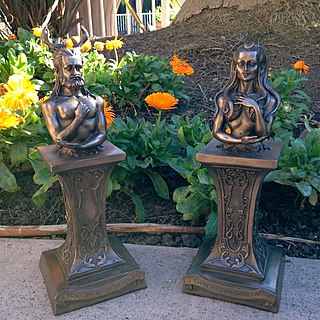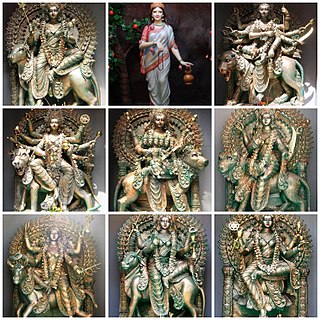Related Research Articles

Artemis is the Greek goddess of the hunt, the wilderness, wild animals, the Moon, and chastity.

In ancient Greek religion and mythology, Demeter is the goddess of the harvest and agriculture, presiding over grains and the fertility of the earth. Her cult titles include Sito (Σιτώ), "she of the Grain", as the giver of food or grain, and Thesmophoros, "Law-Bringer", as a mark of the civilized existence of agricultural society.

A goddess is a female deity. Goddesses have been linked with virtues such as beauty, love, motherhood and fertility. They have also been associated with ideas such as war, creation, and death.

Parvati, Uma or Gauri is the Hindu goddess of fertility, love, beauty, marriage, children, and devotion; as well as of divine strength and power. Known by many other names, she is the gentle and nurturing aspect of the Supreme Hindu goddess Adi Parashakti (Shivashakti) and one of the central deities of the Goddess-oriented Shakta sect. She is the Mother goddess in Hinduism, and has many attributes and aspects. Each of her aspects is expressed with a different name, giving her over 100 names in regional Hindu stories of India. Along with Lakshmi and Saraswati, she forms the trinity of Hindu goddesses (Tridevi).

Durga, identified as Adi Parashakti, is a principal and popular form of the Hindu Goddess. She is a goddess of war, the warrior form of Parvati, whose mythology centres around combating evils and demonic forces that threaten peace, prosperity, and Dharma the power of good over evil. Durga is also a fierce form of the protective mother goddess, who unleashes her divine wrath against the wicked for the liberation of the oppressed, and entails destruction to empower creation.

A mother goddess is a goddess who represents or is a personification of motherhood. When equated with the Earth or the natural world, such goddesses are sometimes referred to as Mother Earth or as the Earth Mother. The concept is complementary to a "Sky Father" or "Father Sky".

The Triple Goddess is a deity or deity archetype revered in many Neopagan religious and spiritual traditions. In common Neopagan usage, the Triple Goddess is viewed as a triunity of three distinct aspects or figures united in one being. These three figures are often described as the Maiden, the Mother, and the Crone, each of which symbolizes both a separate stage in the female life cycle and a phase of the Moon, and often rules one of the realms of heavens, earth, and underworld. In various forms of Wicca, her masculine consort is the Horned God.

The Goddess movement includes spiritual beliefs or practices which emerged predominantly in North America, Western Europe, Australia, and New Zealand in the 1970s. The movement grew as a reaction to perceptions of predominant organized religion as male-dominated, and makes use of goddess worship and a focus on gender and femininity.

Vaishno Devi, also known as Mata Rani, Trikuta and Vaishnavi, is a manifestation of the Hindu Goddess Mata Adi Shakti/Adi Parashakti. The words "Maa" and "Mata" are commonly used in India for mother, and thus are often heavily used in connection with Vaishno Devi.

Navadurga, are nine manifestations of the goddess Durga in Hinduism, especially worshipped during the festival of Navratri where each of the nine manifested forms are venerated respectively for each night. The nine forms of Goddess Durga or (Parvati) are: Shailaputri, Brahmacharini, Chandraghanta, Kushmanda, Skandamata, Kaalratri, Katyayani, Mahagauri and Siddhidhatri.

Nisaba, is the Sumerian goddess of writing, learning, and the harvest. She was worshiped in shrines and sanctuaries at Umma and Ereš, and was often praised by Sumerian scribes. She is considered the patroness of mortal scribes as well as the scribe of the gods. In the Babylonian period, her worship was mainly was redirected towards the god Nabu, who took over her functions.

Kali, also known as Kālikā or Shyāmā, is a Hindu goddess. Kali is one of the ten Mahavidyas, a list which combines Sakta and Buddhist goddesses.

Devī is the Sanskrit word for "goddess"; the masculine form is Deva. Devi – the feminine form, and Deva – the masculine form, mean "heavenly, divine, anything of excellence", and are also gender specific terms for a deity in Hinduism.

Mumba Devi Mandir is an old temple in the city of Mumbai, Maharashtra dedicated to the goddess Mumbā, the local incarnation of the Devi. Marathi Mumbā derives from Sanskrit While Hindu sects devoted to the goddess Mumbadevi are attested to as far back as the 15th century, it is said that the temple was built in 1675 near the main landing site of the former Bori Bunder creek against the north wall of the English Fort Saint George by a Hindu woman also named Mumba. The creek and fort are now deteriorated to a point at which they are but derelict reminders of the city's past. The temple, on the other hand, is still active.